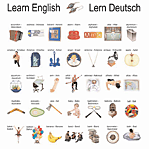Topic 2: Cultural Geography of Germany

Lesson 2: The student will explain the relationship between language and culture.
Lesson Objective
What are some commonly used words in the German language?
Materials and Resources

Transparencies 5A-E -
“Let’s Learn German”
- Worksheet 9 - “English/German Terms”
- Teacher Resource 5 - “Greetings”
Strategies
English and German come from a common source called Germanic languages. Around the year 400 A.D., Germanic-speaking tribes from northern Germany sailed to the British Isles, stayed there and kept their language. That’s why many English and German words are similar:
| English | German |
|
house wind water father mother good peppermint apple fish |
Haus Wind Wasser Vater Mutter gut Pfefferminz Apfel Fisch |
The Transparencies 5A-E “Let’s Learn German,” present students with an alphabetical listing of words which are similar in both languages. Ask students to identify 10 words in German and write a brief definition in English.
The first group of German settlers came to America in 1608. German has always been spoken in the United States, and German books and newspapers have been printed in America. Today, we learn each other’s language in school.
To introduce students to the German language, distribute Worksheet 9, “English/German Terms.” Ask students to complete the chart by adding the English translation of the German word. Have students practice repeating the words orally. The teacher may wish to make flash cards with an English word on one side and the German word on the opposite side. Also, labeling selected items in the classroom will show students similarities in the two languages:
| English | German | Pronunciation |
|
desk chair window door light school clock boy girl book pen pencil dictionary teacher |
Tisch Stuhl Fenster Tür Licht Schule Uhr Junge Mädchen Buch Kugelschreiber Bleistift Wörterbuch Lehrer (male) Lehrerin (female) |
tish shtool FEHNST-uh tewr likht SHOOL-uh OO-ere U-nge MAYT-khen bookh KOOG-elshreyb-uh BLEYE-shtift VER-tehr-bookh LAYR-uh LAYR-uh-rin |
[Note that all nouns in the German language begin with a capital letter. This is true even when they appear “inside” a sentence.]
Teacher Resource 5, “Greetings” is provided for teachers desiring to teach students frequently used expressions in the German language. Explain to students that adults in Germany only refer to each other on a first name basis if they are personal friends in a social setting. Business associates and casual friends are referred to as Mr. or Mrs. [Herr, Frau, whereas the form for “Miss” = “Fräulein” has become very outdated in all German speaking countries].
The German language is also spoken in Switzerland and Austria. For more information about these countries, contact their embassies in Washington, D.C.
Adresses:
| Austria: |
Austrian Embassy 3524 International Court N.W. Washington, D.C. 20008 Tel.: (202) 895-6700 E-Mail: washington-ob@bmaa.gv.at |
| Switzerland: |
Embassy of Switzerland 2900 Cathedral Ave. N.W. Washington, D.C. 20008 Tel.: (202) 745-7900 Fax: (202) 387-2564 Internet: www.swissemb.org E-Mail: vertretung@was.rep.admin.ch |

 Printable PDF
Printable PDF